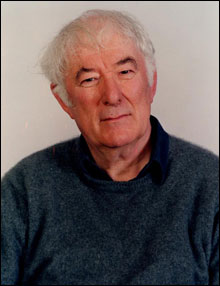
INSIDE OUT: Heaney writes about a turnip snedder, a Boston fireman’s helmet, Wordsworth’s ice skates, a coal scuttle, and a stove lid. |
“District” in Seamus Heaney’s title might mean the places where his imagination has jurisdiction and holds sway. “Circle” is easier. Poems in this book circle back to his childhood, his love of things, to Wordsworth, a formative and continuing influence, to the Tollund Man and, in the last poem, to the signal event in his youth, the accidental death of his younger brother. This book does not come full circle but expands outward as the past resonates “Always new to me, always familiar.” The poems achieved are graspable physical objects, not “infinite,” but so wide and so deep, and solid.The first poem, “The Turnip-Snedder” (Hughie O’Donoghue’s photograph of the machine and its teenage worker is on the book’s cover), begins, “In an age of bare hands,” reminding us that from the start Heaney meant to write handmade poems built out of his feel for words. Another of the book’s widening circles is the appeal things long lived with have for him. He knew the turnip snedder from his youth, and he also writes about a Boston fireman’s helmet, Wordsworth’s ice skates, a coal scuttle, and a stove lid. About is the wrong word. Heaney writes from the inside out — you don’t just see what is described, you hold and heft the thing. He is as adept, masterful in fact, at physical actions. “A Shiver” asks the man swinging the sledge whether it does him good “To have known it in your bones, directable,/Withholdable at will,/A first blow that could make air of a wall,/A last one so unanswerably landed,/The staked earth quailed and shivered in the handle?” We can’t answer for the man, but the feel is palpable enough to carry wider circles of ambiguity, the shock of force in the world, that are among this book’s deeper notes.
“A Shiver” is a sonnet, and so are the sequences titled “District and Circle” and “The Tollund Man in Springtime,” and a half-dozen other poems in this book. Heaney’s sonnets are containers that, like musical instruments, contain sounds. The form holds the energy of his words and thoughts, his music, and simultaneously releases it. No poet alive uses the sonnet with such ease and power. He has made something old new again.
For American readers, “Anything Can Happen” — “Anything can happen, the tallest towers/Be overturned, those in high places daunted” — will have special meaning. Written “after Horace, Odes, I, 34,” the poem tells a historical, hypocrite America that fate has reversals in store for us as it has for every empire. Our outraged innocence may blind us to the idea that actions have consequences, but it cannot free us from such consequences. We who have “hurled thunderbolts” have thunderbolts hurled at us in return.I can’t claim these thoughts as Heaney’s intention, but his poems do travel out from their core. His concerns may be local, often determinedly so, but his poems reverberate at large, far from home. Cambridge congressman Tip O’Neill declared “all politics” to be “local.” Heaney may agree. If we grasp what happens in our district, and within the circles in which we move, we earn the wherewithal and the opportunity to imagine the world outside. The poetry Heaney writes is a map and a guide. Not because it is his program to do so but because, as he said in his Nobel Prize lecture, “poetry can make an order as true to the impact of external reality and as sensitive to the inner laws of the poet’s being as the ripples that rippled in and rippled across the water in that scullery bucket fifty years ago.” His focus holds steady.